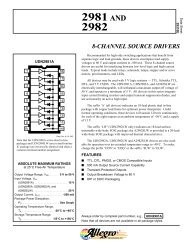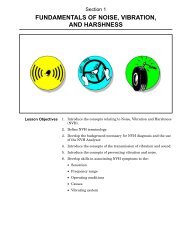how to use this manual general information - 757.org
how to use this manual general information - 757.org
how to use this manual general information - 757.org
You also want an ePaper? Increase the reach of your titles
YUMPU automatically turns print PDFs into web optimized ePapers that Google loves.
IN–24 INTRODUCTION – HOW TO TROUBLESHOOT ECU CONTROLLED<br />
SYSTEMS<br />
1997 TOYOTA T100 (RM507U)<br />
FI0046<br />
FI0047<br />
FI0048<br />
HOW TO USE THE DIAGNOSTIC<br />
CHART AND INSPECTION<br />
PROCEDURE<br />
IN02K–01<br />
1. CONNECTOR CONNECTION AND TERMINAL IN-<br />
SPECTION<br />
� For troubleshooting, diagnostic trouble code charts or<br />
problem symp<strong>to</strong>m charts are provided for each circuit with<br />
detailed inspection procedures on the following pages.<br />
� When all the component parts, wire harnesses and connec<strong>to</strong>rs<br />
of each circuit except the ECU are found <strong>to</strong> be<br />
normal in troubleshooting, then it is determined that the<br />
problem is in the ECU. Accordingly, if diagnosis is performed<br />
without the problem symp<strong>to</strong>ms occurring,refer <strong>to</strong><br />
step 8 <strong>to</strong> replace the ECU, even if the problem is not in the<br />
ECU. So always confirm that the problem symp<strong>to</strong>ms are<br />
occurring, or proceed with inspection while using the<br />
symp<strong>to</strong>m simulation method.<br />
� The instructions ”Check wire harness and connec<strong>to</strong>r” and<br />
”Check and replace ECU” which appear in the inspection<br />
procedure, are common and applicable <strong>to</strong> all diagnostic<br />
trouble codes. Follow the procedure outlined below<br />
whenever these instructions appear.<br />
OPEN CIRCUIT:<br />
This could be due <strong>to</strong> and a disconnected wire harness, faulty<br />
contact in the connec<strong>to</strong>r, a connec<strong>to</strong>r terminal pulled out, etc.<br />
HINT:<br />
� It is rarely the case that a wire is broken in the middle of<br />
it. Most cases occur at the connec<strong>to</strong>r. In particular, carefully<br />
check the connec<strong>to</strong>rs of sensors and actua<strong>to</strong>rs.<br />
� Faulty contact could be due <strong>to</strong> rusting of the connec<strong>to</strong>r<br />
terminals, <strong>to</strong> foreign materials entering terminals or a deformation<br />
of connec<strong>to</strong>r terminals between the male and<br />
female terminals of the connec<strong>to</strong>r. Simply disconnecting<br />
and reconnecting the connec<strong>to</strong>rs once changes the<br />
condition of the connection and may result in a return <strong>to</strong><br />
normal operation. Therefore, in troubleshooting, if no abnormality<br />
is found in the wire harness and connec<strong>to</strong>r<br />
check, but the problem disappears after the check, then<br />
the ca<strong>use</strong> is considered <strong>to</strong> be in the wire harness or connec<strong>to</strong>rs.<br />
SHORT CIRCUIT:<br />
This could be due <strong>to</strong> a connect between the wire harness and<br />
the body ground or <strong>to</strong> a short occurred inside the switch etc.<br />
HINT:<br />
When there is a short between the wire harness and body<br />
ground, check thoroughly whether the wire harness is caught<br />
in the body or is clamped properly.





